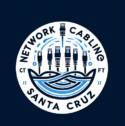How Do You Determine the Best Cable to Use in a Network?
Choosing the right cable is one of the most important decisions when setting up a reliable network. Whether you’re designing a home office, upgrading a commercial building, or expanding an entire IT infrastructure, the type of network cable you select can greatly impact your system’s speed, stability, and performance.
In this guide, we’ll break down the key factors that help determine the best cable to use in a network, including cable categories, applications, and real-world considerations. Our team of structured cabling experts in Santa Cruz helps businesses choose the right cables to ensure optimal network performance and reliability.
Understanding Network Cables
A network cable is the physical medium that connects your devices — like computers, servers, and routers — allowing them to communicate and share data. The most common types used in modern networking are Ethernet cables (twisted pair) and fiber optic cables. Each has its own strengths, limitations, and ideal use cases.
Step 1: Identify Your Network’s Purpose and Requirements
Before choosing a cable type, consider what your network needs to do.
Ask yourself:
- How fast does your network need to be?
- How far will the cable run?
- How many users or devices will connect?
- Is the environment residential, commercial, or industrial?
These questions help narrow down which category or type of cable fits best.
For example:
- A small home network may only need CAT5e or CAT6 cabling.
- A large business might require CAT6A or fiber optic cabling for speed and distance.
Step 2: Understand the Different Cable Categories
Ethernet cables are classified into categories (CAT), each supporting different speeds and frequencies:
| Cable Type | Speed Capacity | Maximum Distance | Best For |
|---|---|---|---|
| CAT5e | Up to 1 Gbps | 100 meters | Small offices, basic home networks |
| CAT6 | Up to 10 Gbps | 55 meters (10G) / 100m (1G) | High-speed offices, gaming, streaming |
| CAT6A | Up to 10 Gbps | 100 meters | Data centers, business networks |
| CAT7 / CAT8 | Up to 40 Gbps | 30–50 meters | Advanced enterprise setups |
| Fiber Optic | Up to 100 Gbps+ | Several kilometers | Backbone connections, large campuses |
The higher the category, the better the cable performs — but also the more it costs.
Step 3: Consider Your Network Environment
Your installation environment plays a big role in cable selection.
- Indoor use: Standard Ethernet cables work well in temperature-controlled spaces.
- Outdoor or industrial environments: Use shielded or weather-rated cables to resist moisture and interference.
- Plenum spaces (above ceilings or air ducts): Use plenum-rated cables (CMP) that meet fire-safety codes, especially in California and other states with strict building regulations.
If your environment involves heavy electrical interference (like factories), shielded twisted-pair (STP) cables are preferred to prevent signal loss.
Step 4: Evaluate Performance and Future-Proofing
It’s always best to think long-term when choosing network cabling. Upgrading later can be expensive and time-consuming.
For example:
- CAT5e may be enough for current use, but CAT6 or CAT6A provides future-ready performance.
- If you plan to add more devices, video surveillance, or cloud-based systems, it’s worth investing in higher-category cables now.
Future-proofing helps you avoid reinstallation costs when bandwidth demands increase.
Step 5: Compare Copper vs. Fiber Optic Cables
| Feature | Copper (Ethernet) | Fiber Optic |
|---|---|---|
| Speed | Up to 10 Gbps (CAT6A) | Up to 100 Gbps+ |
| Distance | Up to 100 meters | Up to several kilometers |
| Interference | Moderate | Very low |
| Cost | Lower | Higher |
| Installation | Easier | Requires specialists |
- Copper cables (CAT5e, CAT6, CAT6A) are great for short runs within buildings.
- Fiber optic cables are ideal for long-distance backbone connections, between floors, or across campuses.
Step 6: Follow Standards and Compliance
When installing network cabling, make sure your setup meets industry and local standards, especially in states like California. These include:
- ANSI/TIA-568 – Data cabling performance standard
- TIA-569 – Pathways and spaces guidelines
- TIA-606 – Labeling and documentation standard
- California Building Code (Title 24) – Fire safety and environmental standards
Hiring a certified network cabling installer ensures full compliance and optimal performance.
Step 7: Get Professional Installation and Testing
Even the best cables won’t perform well if they’re installed incorrectly.
Professional installers:
- Test every cable for speed and signal loss
- Use proper routing and termination techniques
- Label and document your entire network
- Ensure compliance with state and national codes
This guarantees you get the performance you paid for — without connectivity issues or costly downtime.
Common Mistakes to Avoid
- Choosing low-quality cables to save money
- Mixing different cable types without proper planning
- Ignoring shielding or fire-rating requirements
- Running network cables too close to electrical wiring
- Forgetting to label or document installations
Avoiding these pitfalls ensures a cleaner, faster, and more reliable network. Once you’ve selected the right cable, you’ll also need the proper hardware. Learn which component is required to connect a network cable to a computer to complete your setup.
The Bottom Line
Determining the best cable for your network depends on your specific needs — including speed, distance, environment, and future growth. For most setups, CAT6 or CAT6A cabling offers the perfect balance between performance and affordability.
For larger or high-performance networks, fiber optic cabling is the gold standard for speed and distance.
When in doubt, consult a licensed network cabling professional who can design and install a system that meets your exact requirements.
